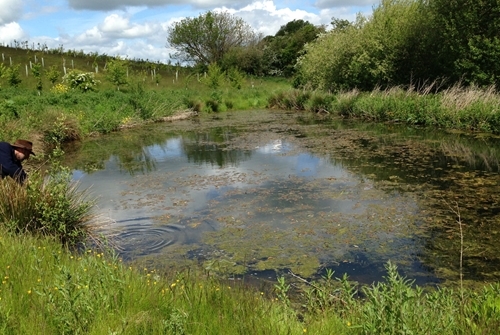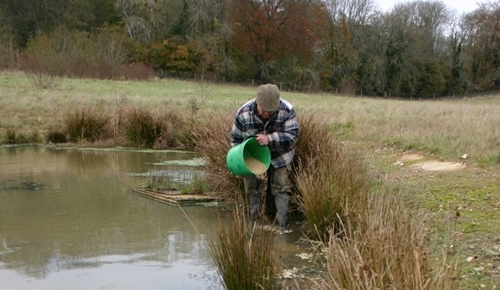
by Mike Swan, GWCT Head of Education
5 minute read
With the home bred ducks busy with their test flights, and the first autumn migrants arriving, now is the moment to start feeding your flight pond. With luck, some of the families will have mums and dads that visited you last season, so will be only too happy to investigate now. Wouldn’t it be a pity if they found that the cupboard was bare?
Be careful though, grub left uneaten can go sour quickly, especially in warm weather. This can make it unappetising, as well as potentially polluting your pond. What you choose to feed has a big influence here, and I prefer barley as the staple. Methinks that as it starts to ferment, it goes kind of beery, and the ducks seem to like that. Clearly, its also the case that enough is enough.
For most ponds, half a bucket scattered widely in the margins is a good start. If you then keep an eye and spot for it disappearing, you can top up as needed. Being in moult, ducks leave lots of calling cards at this time of year too, so look out for their feathers floating in the margins as a sign of visits.
Other foods
Mallard will happily eat wheat as well as barley, but I have a hunch that it goes sour more quickly, so is probably not the best thing to start off with when you are not sure if any ducks are visiting. I also think it may be less attractive to other species like teal and gadwall. Teal like small seeds, so the likes of millet and canary seed are worth a try, but they are likely to be much more expensive, unless you happen into some that has been downgraded.
Back in my early days at GWCT I heard of a large consignment of over ripe bananas that had become available due to a strike at Southampton docks. Apparently, the local mallard were very happy with them, but the pond smelt of rotting bananas for months afterwards. Methinks that dumping them in the water would have done nothing for its quality, nor for the conservation value of the pond. The same applies to the oft quoted idea of using rotten potatoes, or even rabbit guts. Mallard may well be happy to guzzle these things, but the pollution risk seems too high to me.
Rats
When food gets dumped into the water in quantity like this, it can often draw rats, and that is bad for conservation. Even a little barley in the margins can draw these unwanted visitors, and I remember my dismay when I started to find dead frogs in a pond that I was feeding. It soon became clear that rats were doing this, when I found a couple of frogs dragged into one of their burrows.
While I do not think you need to worry about predators of the ducks themselves during the shooting season, running a few traps must be a good idea to help suppress any rats. I would also suggest putting a GWCT mink raft on a quiet corner of your pond. A visiting mink is not that likely to pose a predation issue for ducks flighting to the pond at night in winter, but it could just scare them away, and catching it will surely help other wildlife in the vicinity.

A little and often
As hinted above, leaving food to rot in the shallows is a bad idea. Our rule of thumb should be to put in a little food at frequent intervals. In an ideal world, you would visit your pond daily, check for leftovers, and scatter a ration which is adjusted accordingly. This is clearly very time consuming, and an alternative that is worth considering is to set up an automatic feeder to scatter a small amount in the shallows each day.
Fixing up a plywood baffle on the landward side, for the corn to bounce off, is a great way to ensure that most of the barley falls into the water for the ducks, rather than on the banks to draw rats. As duck numbers build towards a proposed flighting date, you can top up the supply by hand, which is probably easier than fiddling with the settings on the auto feeder.
A pond for wildlife
Many conservationists think that ponds used for flighting are a wildlife disaster, but this need not be true. If you release ducks on a pond, feed, and have them there 24/7 you will inevitably add nutrients to the water, and that is rarely good for wildlife.
But, if you just feed gently to attract wild ones in season, you will probably have a lot less birds, and they will only be there whilst they feed under cover of darkness. My own little Dorset flight pond is managed this way, and has breeding frogs, toads and two species of newts, as well as a healthy range of aquatic insects.
We have studiously avoided introducing any fish since it was first made 25 years ago, and there are no trees close by. People seem to think that ducks need trees and shrubs for shelter in the way that pheasants do, but what of the birds that sit out a winter gale in the middle of an estuary, loch or reservoir?
Many ponds that used to attract duck well, but no longer do have become so heavily overgrown by trees that the birds struggle to get in and out. Clearing these back will often see a dramatic improvement in visit rate. It will also allow the sunlight back in, encouraging the bankside rushes to grow, and let the breeze ruffle the water and oxygenate it; all things that will improve the aquatic environment for a whole host of wildlife.
When to flight
I always like to spy my pond and count the ducks in a night or two before a flight. This is almost as exciting as an actual flight, and gives me the confidence to ask a chum, or the evidence to postpone according to what I see. When it comes to the actual evening, I prefer a dark and breezy one, with no moon.
When the moon is up the ducks can come at any time, or not at all, but on dark evenings they usually turn up at a predictable time. Wind helps to break up the bigger flocks, and carries away the noise of the bangs, so causing less disturbance to the next wave of arrivals.
Avoiding the full moon means that I rarely flight my pond more than once in three weeks, and in practice a flight each month at around the time of the new moon gives me about half a dozen chances each season. I am also very much for picking up as we go along, and leaving as soon as we have enough birds in the bag; a brace each for dinner, and a spare brace to say thank you to the owner sems a very fair result to me. In this way, the later arrivals come in undisturbed, and act as a lead for next time.
At that level, I am confident that I am not being greedy, am doing no harm, and that my pond is a good example of conservation through wise use.
This article first appeared in Shooting Times